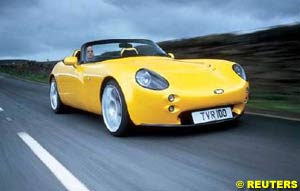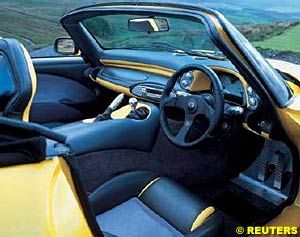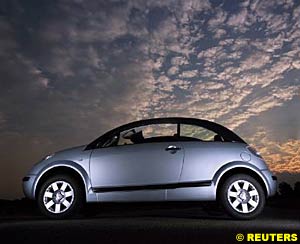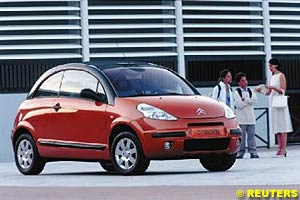

Automotive News and Reviews for the Petrolhead
Reuters Motoring Commentator
In this week's issue:
- TVR - One Man and His Dog
- A Practical Convertible
A month or so back, a legendary character in TVR's history passed away. Known simply as Ned, he was a popular figure, equally at home on the factory floor or his personal boardroom chair, and as a particular favourite of the boss he undoubtedly enjoyed a few company perks too.
Which is only to be expected since Ned was the faithful canine companion of TVR Chairman, Peter Wheeler, the charismatic Yorkshireman responsible for transforming the Blackpool manufacturer from an admirable, but ailing, automotive afterthought into a cogent car company. But just as TVR is no ordinary car firm, Ned was no ordinary dog. Ned helped design a car.
Canine Caper
The car in question, the TVR Chimaera, eventually went into production with a pair of matching 'bite holes' beneath the headlights and was launched at the 1992 UK Motor Show. To date, over 10,000 examples have been sold, making it the most popular TVR ever. And its front indicators are recessed into a brace of scoops that are only there because the Chairman's dog gate-crashed an R&D study.
Depending upon your point of view this is either the finest tale of idiosyncratic British individualism ever or quite the most ludicrous example of the intolerable amateurism that is symptomatic of Britain's failure to keep up with the rest of the world. Whichever way you see it, it is one of many such anecdotes that offer clues as to what makes TVR unique. On the one hand, how can 10,000 Chimaera drivers be wrong; on the other, how many of them might gladly swap 'Design By Ned' for 'Electrics That Work' after finding themselves parked at the side of the road, bonnet up and awaiting relay recovery?
Seat-of-the-Pants Motoring
The issue of TVR reliability need not distract us here. Speak as you find in my view and, generally in life, for every woebegone tale of frustration you'll find another story of sublime satisfaction to balance it out. I have driven old TVRs, new TVRs and press fleet TVRs without any personal cause for complaint, although I've never been an owner. But TVRs are not drive-it-everyday-through-heavy-traffic-no-matter-what cars despite what their contemporary popularity has led many to believe. TVRs are the seat-of-the-pants epitome of sexy motoring and nobody has sex every day, I'm regularly assured. They are seriously fast, sensuously styled, luxuriously appointed and unfettered by auto-anaesthetics such as traction control, stability control or an ABS system. In a TVR, if you don't want to lock up the brakes, don't brake too late; if you'd rather avoid losing the rear end on a wet roundabout, don't mash the throttle to the floor halfway round it. Nobody buys a Slipknot album if David Gray is more their speed but I suspect some buy a TVR when a convertible Audi A4 might be rather more to their liking.
Whatever the generic merits and discredits of a TVR, the company has come a long way since Wheeler took over in 1982. The man himself claims he bought the company simply because 'it was something to do' and as an existing TVR owner, he felt certain he could improve the product. He can sleep easily at night on that score. In the old days, a TVR was an incongruous little car from Blackpool, built on a lightweight tubular chassis and powered by a six cylinder or V8 engine. It was most likely to be owned by the kind of 'bloke' who played badminton on week nights and drank real ale at the weekend (with apologies to Peter Wheeler). These days, the chassis/engine formula is no different but the owners certainly are. I've no idea how many TVRs have been bought by those who work in London's square mile, but the only places you're likely to find more are the players' car park at Old Trafford or outside the Met Bar/China White/Sketch, abandoned with the hood down. Over the last 10 years, it has become seriously cool to drive a TVR.
The Beauty from Blackpool
The entry-level model, the Tamora, is a good example of what makes a TVR so appealing. Its dimensions are perfect, roughly Mazda MX-5 size, and its looks are a tantalising combination of svelte beauty and brutal purpose. Under the bonnet is a 3.6 litre, straight-six, 24 valve heart, but unlike the engines fitted to TVRs of yesteryear, this is no cast-off from Ford or Rover. Since 1996, all new TVRs have been powered by engines designed and produced at its own engineering subsidiary, TVR Power. In the last seven years, three new units have been developed into production, a quite remarkable achievement for such a low-volume manufacturer. That one of these engines is a spine-crumbling 880bhp, 7.7 litre V12, partially developed to help TVR compete in the GT1 class at Le Mans, is more impressive still.
Not that the Tamora is exactly down on power, with 350bhp bursting to urge a chassis weighing barely 1,000 kilos up the road. It is enough to help the Blackpool baby pass 60mph in just 4.4 seconds before reaching a top speed of 170mph, should you wish to endanger life and licence. But like all TVRs, the Tamora is about more than just outright speed. This car handles and rides like a sports car should. The absence of ancillary electronic systems (save for power steering) ensures you always have a real sense of what is going on beneath you but it is the steering that lingers in the memory longest. Direct, fast and just the right weight, it has the sort of feel that the new BMW Z4, as wonderful a car as it is, is sadly lacking.
Attention to Detail
Which is a commodity TVR offers in abundance. Every car they make is built to order and hence quite probably unique. These days the company mixes its own paint, manufactures its own multi-function electronic dashboards, fabricates its own composite seats and mills its own switchgear from aluminium. It is the sort of attention to detail that ought to be a source of embarrassment to certain other famous British sports car firms as well as conclusive proof that here is a company run in a manner that is all too rare today. I haven't a clue what TVR's financial position is but in the 21 years since Peter Wheeler took over, the factory has expanded, production is running at around eight times what it was in 1982 and TVRs are driven by soccer stars and city boys. It would seem Wheeler, and his company, are doing something right.
But then Peter Wheeler is more likely to be found nibbling a sandwich on the shop floor with his engineers rather than slurping down bouillabaisse with accountants on the third Monday of each month. The Tamora, like all TVRs, is an example of what can be achieved when the heart is allowed to rule the head and priority is given to those things in life that matter. Ultimately, TVRs are designed without fear and, on one memorable occasion, with a little bit of help from a dog. RIP Ned.
I am old enough to remember that when the venerable Range Rover was first launched in 1970, it was presented as 'four cars in one.'
You know the marketing: hard-nosed off-roader, luxurious limousine, blah blah blah. It's 30 years on but the marketing gimmicks haven't changed, as Citroen is going one better: it says its new C3 Pluriel is no less than five cars in one.
Avoiding all attempts to underplay the Pluriel, Citroen boasts that its newcomer gives you five body styles. While there's certainly plenty of puff in the assertion, to give them credit, there is a germ of truth there too. So which five cars exactly are you going to get when you buy one Citroen C3 Pluriel?
Nice Little Hatchback
Number two: a body style that neither I nor you have ever heard of, something Citroen describes as 'panoramic'. What this means is basically a sunroof. Let's face it, that hardly counts as a body style, does it? But it works well: you twist a knob, even on the move, and the fabric roof slides back. To lend a bit more of an open-air feel, you can wind the four pillarless electric windows down individually.
Body style number three: full cabriolet. This is where things start to get a bit complicated. You press the knob above your head again and the folded roof moves down to cover the rear screen. Then you get out of the car, pop the boot open, remove the boot cover, and finally unclip and pivot the combined roof and rear screen down into a crevasse in the boot floor. Phew! All that fiddling and effort gives you only a tiny bit of extra open air feel and what's more, you can't do it while you're on the move.
Giant Coat Rack
So how does the Pluriel try to redeem itself with body style number five? It becomes a pick-up. Flop the rear seats down and you get a long load-bay, while the fold-down tailgate can take 100kg. Shame you can't drive legally with the boot lid folded down, like you could with the very first Minis. But at least the Pluriel can hump an old fridge down to the dump, which is more than you can say for any other convertible I can think of.
Floppy Bunny
To drive, the Pluriel is very much like the C3 - except for two factors. Firstly, the loss of the roof, B-pillar and C-pillar makes the car a floppy little bunny. It's not as bad as I was expecting, though, and doesn't affect the C3's solid if unspectacular handling. Secondly, there's a whole spectrum of creaks, groans and wind noise from the windows and roof when it's all closed up.
The 1.6-litre version comes with Sensodrive automatic transmission as standard, which gives you the option of doing rally-style gearchanges via little paddles on the steering wheel - although don't expect any rally car feel in action. The Pluriel plays it safe, not fun.
Considering that this is Britain's cheapest four-seater convertible (the 1.4 is £11,995 and the 1.6 is £13,595), equipment levels are fairly generous. All models get an electric roof and windows and a CD player but there is no alarm on the 1.4 and air conditioning is strictly optional on both models (I suppose you do have a roof to roll back).
Does the Pluriel try to be too many things all at once? Possibly, which is why perhaps Citroen kept telling me their car is not a convertible. It's a hatchback.
Written by Chris Rees
![]() TVR - One Man and His Dog
TVR - One Man and His Dog
 Picture this: it's 1992 and the TVR design team are poring over the mock-up of a new prototype when Wheeler's helpful hound skids through the door and proceeds to bite a chunk out of the front of the foam model. Resist the urge to question what the dog was doing there in the first place and simply rejoice at what happened next. The designers looked at each other and then looked again at the hole in their model before agreeing that Ned's impromptu improvisation lent their own handiwork a little something extra.
Picture this: it's 1992 and the TVR design team are poring over the mock-up of a new prototype when Wheeler's helpful hound skids through the door and proceeds to bite a chunk out of the front of the foam model. Resist the urge to question what the dog was doing there in the first place and simply rejoice at what happened next. The designers looked at each other and then looked again at the hole in their model before agreeing that Ned's impromptu improvisation lent their own handiwork a little something extra.
 As a means of transport the Tamora is certainly no gentle, wafting ride but then this is a TVR, not a Lexus. It is also far from unruly. Sure enough, the hallmark growl and burble from the engine is always there and the chassis is race-car stiff but the Tamora still rides and turns with decorum. And anyway, it's a drop-top, two-seat sports car with a 350bhp engine; you pays your money, you takes your choice.
As a means of transport the Tamora is certainly no gentle, wafting ride but then this is a TVR, not a Lexus. It is also far from unruly. Sure enough, the hallmark growl and burble from the engine is always there and the chassis is race-car stiff but the Tamora still rides and turns with decorum. And anyway, it's a drop-top, two-seat sports car with a 350bhp engine; you pays your money, you takes your choice.
![]() A Practical Convertible
A Practical Convertible
 Number one: a nice little hatchback. Here you have to concede that there's no car like the Pluriel - a genuine convertible that also has full tailgate facilities. It's not even a compromised hatchback: OK, you have a split tailgate (window hinges up, boot lid flops down) but it all works surprisingly well. The tailgate opens up on a boot that you can actually use down at Tesco's. Not for the Pluriel the cramped cubby hole that is the Beetle Convertible's boot, you get 137 litres with the seats up and by fold the rear seats down that expands to 266 litres (more than a Fiesta). And yes, you can fit four adults in comfort.
Number one: a nice little hatchback. Here you have to concede that there's no car like the Pluriel - a genuine convertible that also has full tailgate facilities. It's not even a compromised hatchback: OK, you have a split tailgate (window hinges up, boot lid flops down) but it all works surprisingly well. The tailgate opens up on a boot that you can actually use down at Tesco's. Not for the Pluriel the cramped cubby hole that is the Beetle Convertible's boot, you get 137 litres with the seats up and by fold the rear seats down that expands to 266 litres (more than a Fiesta). And yes, you can fit four adults in comfort.
 Number four: Pluriel spider. What's a spider? In Citroen's vocabulary, it is detaching the two roof arches to leave a completely open, true convertible. This is what other convertibles deliver in a matter of seconds but in the Pluriel you have to get out, unclasp each roof rail front and rear, heave them off (they weigh a hefty 12kg each) and hang them on a stand that looks like a giant coat rack. As you can divine, this is neither simple nor convenient. Because you have to leave the roof bars at home, you'd better be sure it isn't going to rain.
Number four: Pluriel spider. What's a spider? In Citroen's vocabulary, it is detaching the two roof arches to leave a completely open, true convertible. This is what other convertibles deliver in a matter of seconds but in the Pluriel you have to get out, unclasp each roof rail front and rear, heave them off (they weigh a hefty 12kg each) and hang them on a stand that looks like a giant coat rack. As you can divine, this is neither simple nor convenient. Because you have to leave the roof bars at home, you'd better be sure it isn't going to rain.
© 1995-2005 Kaizar.Com, Inc. . This service is provided under the Atlas F1 terms and conditions.
|
Volume 9, Issue 28
Atlas F1 Exclusive
Gerhard Berger: So Long to All That
Articles
Tifosi IPO - the Finale
Ann Bradshaw: View from the Paddock
2003 French GP Review
2003 French GP Review
Musical Chairs
In the Balance
Stats Center
Qualifying Differentials
SuperStats
Charts Center
Columns
Season Strokes
On the Road
Elsewhere in Racing
The Weekly Grapevine
> Homepage |